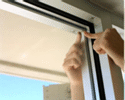B3. Install Window Sun Shades
Description
Solar radiation's heat gain through windows often accounts for 50 percent of air-conditioning load in the summertime. If no existing shading exists in air-conditioned spaces such as offices, community rooms, or lobbies, window shading should be considered.
Applicability
- Air-conditioned office and community space
- Air-conditioned spaces without inter shades, blinds, or tinted glass
- Air-conditioned spaces whose windows are not well-shaded by exterior trees, vegetation, or other buildings
Types
- Exterior shading
- Architectural elements
- Roof overhangs
- Vertical shading devices
- Awnings
- Shading screens
- Architectural elements
- Interior shades
- Blinds
- Curtains
- Sun screens
- Tinted film
Considerations
- Exterior shading should be engineered for correct summer solar angles to ensure effective shading.
- Tinted film is fragile and should not be installed in areas where objects or people come into contact with windows.
- Exterior shading devices should be designed to withstand snow loads.
- Sunshades on south- and west-facing windows can be effective at improving comfort and reducing the need for air conditioning.
- Windows manufactured with low-emissivity (often called low-e) films typically cost about 10 to 15 percent more than regular windows.
- Window treatments do not reduce air leakage and infiltration
Performance/Economics
- Venetian blinds reflect 40 to 60 percent of the sun’s radiant energy. Low-e windows reduce energy costs by approximately 30 to 50 percent.
- Window tinting can reduce solar energy gain 25 to 55 percent.
- Vertical blinds reflect approximately 23 percent of the sun’s radiant energy.
- Roller shades, depending on their composition, reflect 15 to 80 percent of the sun’s radiant energy. Overhangs are most effective at midday.
Resources/Links
Energy Conservation for Housing – A Workbook, HUD, September 1998. Pages 7-17 through 7-20 address energy-saving window sun shades.
Window Treatments and Coverings. Part of the U.S. Department of Energy's Consumer's Guide.
Using the Sun: Using Windows Wisely. Provides information on using film, indoor shading, and vegetation to reduce solar gain.
|
TURN OFF UTILITIES: Turn off electricity, gas, propane, and other utilities before starting repairs, cleaning, or installations to avoid accident or injury. BE AWARE OF LEAD-BASED PAINT HAZARDS: Many residences built before 1978 have paint that contains lead, which can pose a serious health hazard if paint, chips, and dust are not handled properly. See the U.S. Environmental Protection Agency (EPA) lead brief before disturbing painted surfaces in homes of this vintage. Follow the HUD "Lead-Safe Housing Rule" for requirements for notification, evaluation and reduction of lead-based paint hazards. BE AWARE OF ASBESTOS HAZARDS: Homes older than 1977 may have building products that contain asbestos such as insulation, high-temperature gaskets, roofing and siding shingles, and vinyl sheet flooring. See the EPA asbestos brief before disturbing such materials. BE AWARE OF MOLD AND MOISTURE HAZARDS: Molds can gradually destroy materials they grow on; can irritate the eyes, skin, nose, throat, and lungs of both mold-allergic and non-allergic people; can cause asthma attacks in people with asthma who are allergic to mold; and can cause other serious health problems. To learn more about preventing and cleaning up mold in homes, see these mold guides and the EPA brief on What to Wear When Cleaning Moldy Areas. |